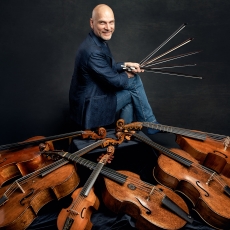Markku Luolajan-Mikkola - J.S. Bach: Complete Sonatas & Partitas - Fanfare
The difference between a partita and sonata in these works tends to be a matter of the number of movements. The three sonatas each have the traditional Baroque four, while the three partitas have as many as eight, configured in the form of a suite. There is one more thing; all were written originally for violin. That performing them on the cello is not entirely a modern convention can be seen in the fact that the obvious iconic works for solo cello, the six suites, were sometimes to be found in Bach's own arrangements for other solo instruments. The fine and informative booklet notes give a couple of examples, such as the Suite in C Minor (BWV 1011) that may originally have been conceived for lute, but which also exists in arrangements for other instruments. Of course, direct transfers of such endemic violin music are not entirely possible on other instruments (save for the keyboard), as technical capabilities and ranges have to be taken into account. That being said, doing the cello suites on the viola or viola da gamba is not entirely problematic, since for the former at least all one has to do is read it an octave higher. But the remainder require transposition, and cellist Markku Luolaja-Mikkola has made a convincing case for his two-disc recording of these violin works on the Baroque cello, all of which have been placed a fourth lower in order to make the ranges fit his instrument better.
The results are extremely gratifying, for not only does Luolajan-Mikkola have the skill and technical capacity to play these horrifically challenging pieces, noting as he does that "it is almost impossible to imagine a cellist of Bach's day playing them," but also making informed suggestions that this may in fact have happened. He cites a 19th-century transcription that is not too far off from his, which may be a copy of something from much earlier. In his own work, however, he goes beyond the historical precedents by paying attention to the tuning of the instrument and even the microphone placement. This results in a generous, resonant sound of the instrument in which the often gnarly double- and triple-stops can be heard in their harmonic fullness. Although in the partitas, the various dance movements have their share of musical interest, such as the lively Bourée of the Third Partita in A major (BWV 1006, here and elsewhere in their transposed keys, not the original) or the quirky Tempo di Boreafrom the E-Minor partita (BWV 1002), it is the Chaconne finale of the second partita in G minor (BWV 1004) that is the telling movement. This is, as he notes, positively "Himalayan" in terms of complexity and degree of difficulty. Luolajan-Mikkola handles it as if it were the simplest minuet, with ease, dexterity, and a phrasing that brings out all of the hidden elements of this most challenging of pieces. For violinists, it is a terrifying monster to be tamed, but here it turns out to be the sort of smooth dance that it was meant to be. The three sonatas, lesser works in terms of length and stylistic complexity than the partitas, are all equally handled with similar fluidity. Even the second movement fugues display each entrance with clarity. For example, the fugue in the D-Minor Sonata (BWV 1003) enters with a short, pithy theme that requires on each successive entrance for the voice to be heard, but the countermelody to be outlined as well. Not surprisingly, Luolajan-Mikkola clarifies each entrance, but gives a fair amount of weight to the episodes, which are more single line, and the sequences that can be done in musical phrase groupings.
This is an outstanding disc with some absolutely phenomenal playing. While some might think these six pieces belong more exclusively to the realm of the violin, Luolajan-Mikkola makes a convincing case for his transpositions, giving them a depth that is truly amazing.

